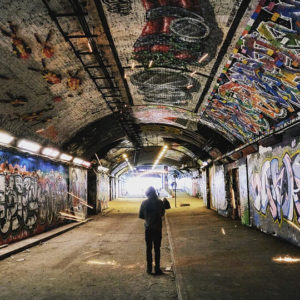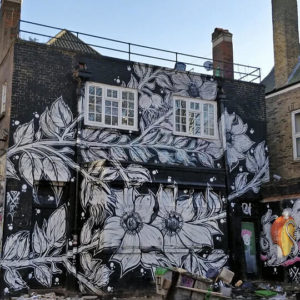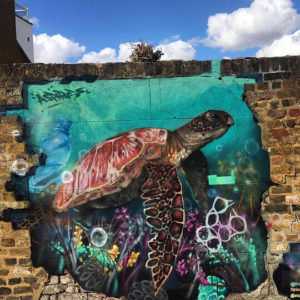
London Street Art and Graffiti Through the Decades: 1960 – 2021
London Street Art and Graffiti Through the Decades: 1960 – 2021
Art, as a whole, has a rich global history that cannot be confined to the contents of one webpage. If a writer were to attempt to jot down every artistic inclination in history, the task would be never ending. There are far too many styles, cultures, movements and creative geniuses to capture a clear image. A writer’s best effort would be to compose a brief yet informative summary of one particular subgroup in one specific destination. Street art in London is a cluster of historical events, fresh styles and talented artists. When discussing art, graffiti and street art is often merely mentioned as a passing comment or acknowledgement. In reality, the history of murals in London are drawing crowds and artists, such as Banksy, are stirring up controversy to inspire different avenues of thinking. But, London street art has far more to offer than Banksy’s cheeky stencils. Over time many elements of graffiti and street art have changed, providing a more accepting audience for emerging artists.
A Brief History of London Street Art
The history of street art in London can be traced back to the early 20th century, when the city was home to a vibrant and thriving underground art scene. London’s street art scene began to emerge in the late 1960s and early 1970s, with the rise of the punk rock and skinhead subcultures. These subcultures were often associated with graffiti and street art, and many of the early London street artists were influenced by these movements.


Street art in London, Inspiring City
1960s
It’s impossible to discuss the history of murals and London graffiti and street art without acknowledging where it began. Graffiti and street art originated in New York as a creative outlet for youths, especially young boys. In 1965, Darryl “Cornbread” McCray unknowingly became the world’s first modern graffiti artist at twelve. As predicted, McCray was a big fan of cornbread and took to the streets to tag his new nickname across the city. The new found love for spray painting prevented young boys such as Cornbread from getting involved with drug use and violence. The scene quickly grew and those involved created an unspoken competition to build their reputations. Tagging hard to reach places, tall buildings or locked up abandoned properties became the canvases for artists to impress their friends. It wasn’t until the end of the 1960s did these graffiti games travel to British shores. London teenagers were influenced by their American counterparts and began behaving similarly.


Darryl “Cornbread” McCray,A History of Graffiti
The London art scene in the 1960s was an interwoven lace of art, music, theatre, fashion and film. There was a vague distinction between the niches, but art as a whole was an undefined cluster. Graffiti art hadn’t truly formed as a style, but that didn’t mean the brick walls were bare. Passionate people took to the walls to promote their personal political beliefs. A prominent form of “wall art” was mass-produced, printed posters. They were anonymous and quick to distribute. Posters or in some cases, stencils were used as a form of propaganda. The anonymous artist had no intention of claiming responsibility for the message, but instead their work sparked a very interesting an anonymous dialogue. Society didn’t receive these stencils and posters as art at the time, but they greatly influenced the future of street art.
1970s
It’s crazy to believe that what we know as street art today began as name tagging on the backs of houses. During the mid-1970s, teenage delinquency became the talk of the town as locals awoke to their neighbourhood spray-painted with the nickname “Kix”. Inspired by the graffiti culture of New York City, Kix (more formally known as Lee Thompson) had begun tagging out of boredom. Joined by a band of friends, Kix and his crew painted the town upside down. They followed a flimsy set of rules that meant no tagging on personal property. Although, a few slip-ups resulted in a very pointed Times article. “I came out of my garage recently to find that people had sprayed graffiti on it. If I ever catch that Kix [and his friends Mr B, Clomubo and Cat], I’m going to kick their arses.”


A car tagged with ‘Kix’ // 1970s graffiti, The Guardian
Street artists of the 1970’s are often described as the pioneers of British graffiti. Youths would use spray paint to emote the feelings they couldn’t otherwise express. “Graffiti was a secret code, the voice of the underdog.” It was often described as another language, some political, some nonsense. Outside of the cries for change, taggers of 1970s London would also write confusing sentiments such as “Remember The Truth Dentist”, “Go And See Stardust With David Essex It’s Really Great,” and “Cats Like Plain Crisps”. It’s hard to decipher precisely what the “artist” was trying to convey, but these phrases remain faded around London.


Street tagging in London circa 1970s, Mashable / The Guardian
A 1970s activist, Mike Lesser, commented on the thrill that encouraged illegal tagging. “You buy a spray can for almost nothing, you write something, you choose a good position, and it takes a bit of time for it to get washed off. You could put up posters, but that takes four or five crews, two or three weeks, and you have to have a very heavy-duty, well-organised outfit.”
1980s
The vibrant nature of the 1980s allowed people to embraced their sense of self. Artists overran the city with decorative displays of graffiti art. They’d “tag” their names in every ally, side street and tube line. Illegal taggers often use pseudonyms to hide their real identity. The tactic is still used today as artists usually go by a fake name, similar to celebrities’ stage names. The popularity of “subway art” was heavily influenced by New York and its street art scene. We reflect on these examples of graffiti art positively, but restaurants and bars didn’t appreciate having their brickwork tagged. The legalities blurred the lines between paid, purposeful work and illegal tagging – no matter how talented the artist was. Ironically, the community was scolding street artists and their work with one hand while the other was marketing media with graffiti lettering and designs.
Illegal street art and mural work differs greatly. Simply, at its core, a mural is a paid service where a piece of illegal street art is… well… illegal. There was plenty of incredible, yet illegal street art in London during the 1980’s, but what about legal art?


Brian Barnes’ anti-war murals London (then and now),FatCap
The London mural art scene commissioned many skilful artists to use their talent for social and political purposes. A powerful mural theme of 1980’s London murals was anti-war, particularly nuclear proliferation. The force behind the commissioning of these murals was particularly left-leaning. A total of six murals were painted under the instruction of the ‘London Muralists for Peace’ group during the early 1980’s. One of the more well known examples, painted by Brian Barnes features a giant skeletal figure swathed in the flags of nuclear states. Murals like Barnes’ can still be found around London (although faded) and many modern artists choose to promote causes through art today.
Outside political pieces, a common trend amongst London mural artists throughout the 1980’s was to paint people in windows. There is no written down phenomenon or explanation to this observation. But many artists simply chose to incorporate a person, usually a woman, in a window. Another major feature (that hasn’t died out) is flora and fauna. Whether it’s local or merely a London artists interpretation of nature, many community murals featured foliage and critters of all sorts.


Window watchers, A London Inheritance
1990s
It was during the 1990s that “graffiti art” truly transformed into “street art.” Perhaps upon reading those words, the difference is unclear – but the distinction is essential. Graffiti style is particular, usually incorporates lettering or the artists’ alias. Street art encompasses emotive design and imagery – a portrait, flora, fauna, a celebrity caricature, a scenic view. Street art is art on the street. Artists would paint beautiful pieces in areas they didn’t have permission to and have their work removed or painted over. In certain circumstances, the art was left but doing this encouraged other artists to paint illegally and seek forgiveness and not permission.
When researching artists in London in the 1990s, the search page is overwhelmed with discussions of Banksy and his identity. Every street art tour in London also contains stops to his work. He is everywhere! But, this wouldn’t be an article covering the modern history of graffiti and street art in London without mentioning Banksy. Arguably, globally, Banksy is the most known street artist outside of the street art community. His “murals” or stencils are most undoubtedly illegal hence his reason for anonymity. The stencils are often humorous images containing thought-provoking messages of anti-war, anti-capitalism or anti-establishment. Those who have had the opportunity to discover the man behind the mural described him as a “white, scruffy casual man, with a silver tooth.” A remarkably unidentifiable description. The 1990’s art scene in London wasn’t entirely about Banksy. He didn’t even live directly in London but in Bristol until the early 2000s.
Young artists chose to take to the streets and promote themselves outside the prestigious gallery system. In brochures, London was portrayed as a tourists dream, but local artists decided to highlight the unforgiving nature of the city through the history of murals. The demolishing of heritage buildings, the abundance of litter and rubbish, homelessness, domestic violence were documented on walls for everyone to see.
2000s
Banksy became a household name by the turn of the century. A decade later and he was titled as one of the 100 most influential figures in the world. Throughout the 2000s his work continued to get recognition resulting in high public demand to purchase prints. Banksy made a handful of prints available online at affordable prices. Fans would spend hours waiting and wondering if they’d be able to get their hands on his work. Few were buying to own, most were looking to re-sell for higher prices. Banksy’s prints increased fivefold in value in under 24 hours. The financial crisis in 2009 hit street artists hard, but Banksy’s work remained unaffected and in continuous demand.


Love is in the Air (Banksy Flower Thrower), Banksy – 2003 / Girl with a Balloon, Banksy – 2002, Artsy
The Shoreditch area of London is recognised and appreciated for its influx of street art. Prior to the early 2000s, Shoreditch wasn’t on a tourists list of places to visit. Shoreditch’s history rests on the shoulders of textiles and furniture trade. The large industrial buildings made up of brick and cement became perfect canvases for illegal taggers. Throughout the late 90s, Shoreditch fell victim to disarray and the ugly side of graffiti – disrespect and vulgarity. Mural art and street art slowly began to replace tagging throughout the early 2000s. It took time, but eventually a new found respect for the spray can was born.
2010s
The most famous graffiti spot in London is Brick Lane (and its surrounding alleyways and paths). It’s traditional brickwork and long unwavering history intertwine the old with the new world of street art. Mural artists in London are hired to bring their brush and paint down to Brick Lane for large scale, yet temporary projects. Book An Artist was commissioned to paint a spectacular mural on Brick Lane in 2019. London mural artist, Jay, painted for ‘one’ of the ‘directions’, Louis Tomlinson to create buzz for his new album. What could be more fitting for an album titled ‘Walls’ than a personalised mural on a literal wall? Fans flooded the streets in hopes of catching a glimpse of the superstar singer (a.k.a. Louis Tomlinson – although, Jay is our personal superstar).


Brick Lane mural commissioned through Book An Artist for Louis Tomlinson – 2019, Jay
The mural, much like other commissioned murals painted on Brick Lane, was eventually covered with a new piece. Brick Lane’s ever changing facade means locals get to enjoy a new and exciting project regularly. Despite the wider acceptation and appreciation for street art, there are still those who consider it a controversial career path. Another beloved mural art site, the Seven Stars Yard, was purchased by developers and mural art is now prohibited. The Seven Stars was a former pub turned graffiti location. The disheveled building off Brick Lane was embraced by local artists and transformed with spray paint and paste-up posters. Regardless of rules and legalities, artists have continued to throw up new pieces on the side of the building.


The Seven Stars Yard, Enter Gallery
2021
So, where are we now? Mural art and street art has come a long way since their origins. The history of murals and importance of street art prosper. Artists are passionate, influential people ready to paint for those who believe in them and their message. The street art scene thrives globally, but access to new and upcoming artists is easier. Platforms such as Book An Artist allow everyday folk to step into the world of commissioning artwork. Artists are abundant with unique and exciting styles. While tagging and graffiti got the ball rolling, fine artists and illustrators use their talents to paint London’s walls.


Murals commissioned through Book An Artist in London, Otto / Rob
What can one do with a mural? A mural is an ideal way to transform a boring wall into something personalised. Street art is now used for marketing and advertising. Large companies can connect with artists to represent their brand. Mural artists can beautify residential homes with small details, and offices can inspire their employees with colour and creativity. While there is still a huge underground scene, graffiti art and artists come to the surface to benefit from the growing acceptance. Choosing a mural over mass-produced wallpapers supports local artists and results in a cleaner, more inviting community
FAQs
What are the different types of London Street Art?
There are many different types of London street art, ranging from graffiti to murals to street art installations. Graffiti is probably the most common type of street art in London, and can be found on buildings, bridges, and other structures throughout the city. Some well-known London graffiti artists include Banksy, Shoreditch Tom, and Reka One. Murals are another popular type of street art in London.
What is the impact of London Street Art?
London street art has transformed bare walls into creative outlets for locals to enjoy. Street art and mural art in London acts as a visual descriptor of the local art scene, culture and aesthetic of London.
Who are the most famous London Street Artists for hire?
You may recognise some of the most famous London artists from Book An Artist. We are lucky enough to have many famous street artists using our platform. Some include, Nerone, Keo and Aspire. Their work can easily be seen across London.
Check out top-rated local artists near you!
Are you an artist ? Sign Up












